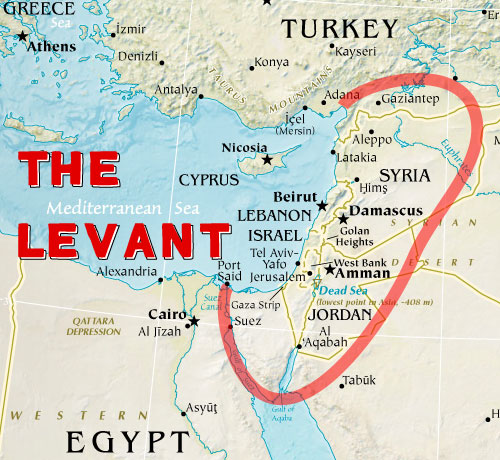Levant is an imprecisely defined region in the Middle East south of the Taurus Mountains, bounded by the Mediterranean Sea on the west, and by the northern Arabian Desert and Upper Mesopotamia to the east.
The Levant is an approximate historical geographical term referring to a large area in the Eastern Mediterranean, primarily in Western Asia.It is a historical region beyond nationalities. In its narrowest sense, it is equivalent to the historical region of Syria. In its widest historical sense, the Levant included all of the eastern Mediterranean with its islands; that is, it included all of the countries along the Eastern Mediterranean shores, extending from Greece to Cyrenaica.

Regions
The term Levant is employed to refer to peoples, states, or parts of states in the region, namely:
· Israel
· Jordan
· Lebanon
· Palestinian Territories
· Syria
Turkey’s Hatay Province, the southern “panhandle” of the country extending towards Syria, may be considered part of the Levant due to its geography, history and culture.
Cyprus is also geographically close but in other matters, it is much more connected with Europe.
Cities
Amman — this modern city is a great launching point for many of Jordan’s attractions
Aqaba — a popular vacation city located on the Red Sea, well known for its wonderful scuba diving and marine life
Beirut — a coastal city with a French influence formerly known as the “Paris of the Middle East”
Damascus — considered by some to be the oldest continually inhabited city in the world, Damascus contains several world-famous Arab souqs
Eilat — a vacation city on the Red Sea, known for its underwater observatory
Jerusalem — quarreled over by Jews and Arabs alike, this famous city is the site of many holy sites of Christianity, Islam, and Judaism
Tel Aviv — a coastal city that is known for its vacationing possibilities, beaches and resorts
The term entered English in the late 15th century from French.It derives from the Italian Levante, meaning “rising”, implying the rising of the sun in the east, and is broadly equivalent to the term meaning “the east, where the sun rises.
In the 13th and 14th centuries, the term levante was used for Italian maritime commerce in the Eastern Mediterranean, including Greece, Anatolia, Syria-Palestine, and Egypt, that is, the lands east of Venice. Eventually the term was restricted to the Muslim countries of Syria-Palestine and Egypt.In 1581, England set up the Levant Company to monopolize commerce with the Ottoman Empire.The name Levant States was used to refer to the French mandate over Syria and Lebanon after World War I. This is probably the reason why the term Levant has come to be used more specifically to refer to modern Syria, Lebanon, Palestine, Israel, Jordan, and Cyprus. Some scholars misunderstood the term thinking that it derives from the name of Lebanon.Today the term is often used in conjunction with prehistoric or ancient historical references. It has the same meaning as “Syria-Palestine” or Ash-Shaam , the area that is bounded by the Taurus Mountains of Turkey in thåe North, the Mediterranean Sea in the west, and the north Arabian Desert and Mesopotamia in the east. Typically, it does not include Anatolia (also called Asia Minor), the Caucasus Mountains, or any part of the Arabian Peninsula proper. Cilicia (in Asia Minor) and the Sinai Peninsula(Asian Egypt) are sometimes included.
The term Levant was widely used to describe the region from the 18th to the mid-19th centuries, and has had steady but lower usage since the late 19th century; several dictionaries consider it to be archaic today. Both the noun Levant and the adjective Levantine are now commonly used to describe the ancient and modern culture area formerly called Syro-Palestinian or Biblical: archaeologists now speak of the Levant and of Levantine archaeology; food scholars speak of Levantine cuisine;and the Latin Christians of the Levant continue to be called Levantine Christians.
The Levant has been described as the “crossroads of western Asia, the eastern Mediterranean, and northeast Africa”, and the “northwest of the Arabian plate”. The populations of the Levant share not only the geographic position, but cuisine, some customs, and history. They are often referred to as Levantines.
Link(s) and Source(s):
https://en.wikipedia.org/wiki/Levant
https://en.wikivoyage.org/wiki/Levant

Pingback: Ma’amoul – Silagh's Stories